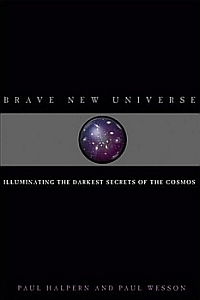Brave New Universe
Illuminating the Darkest Secrets of the Cosmos
By Paul Halpern and Paul Wesson

In this glorious age for cosmology, astronomical measurement has never been more precise. Using modern instruments such as the Wilkinson Microwave Anisotropy Probe (WMAP), astronomers have found answers to long-elusive questions about the age and composition of the universe. With unprecedented confidence, they have revealed how long the cosmos has been expanding since its beginning. They have examined how this growth has changed over time, and have predicted its future course. Moreover, they have sorted the types of matter and energy in the universe into various categories, pinpointing how much of space contains ordinary materials—the stuff of stars and planets—and how much harbors other kinds of substances. By producing such exact results, high-resolution satellite data and novel telescopic techniques have thereby transformed one of the most speculative fields into a triumph for meticulous scientific methods.
Yet, like the excavation of ancient Troy, each layer revealed of cosmic information has unearthed hints of even deeper secrets. As clear data has emerged about the age and composition of the universe, cosmologists have encountered formidable issues underlying these results. For example, if, as the WMAP has revealed, only 4% of the universe constitutes ordinary matter, what is the nature of the remaining material? If, as telescopic measurements have shown, all of space is accelerating, what is producing this fantastic dynamo of energy? And if, as infrared searches have indicated, planetary systems are fairly common throughout the cosmos, why have we yet to encounter extraterrestrial beings?
As we learn more about the universe, we question how much of our experience is a function of our sensory limitations. Might time, space and matter simply be illusions? How do human intelligence and consciousness reflect the nature of physical reality? Does the existence of life on Earth derive from a blend of unique cosmological factors? Brave New Universe addresses these philosophical questions and more—and its conclusions prove most extraordinary!
Buy this book
Praise for Brave New Universe
-
Writing in the tradition of Eddington, Halpern and Wesson combine insights from observational astronomy, theoretical physics, and philosophy of science to provide a picture, on the largest scales, of what we know about our universe and what we might hope to know some day in the future.
—Virginia Trimble
Professor of Physics and Astronomy, University of California Irvine and Chair, Forum on History of Physics of American Physical Society
Book Contents
- Introduction
- The Quest for Cosmic Understanding
- Chapter One
- To See the World in a Grain of Sand: What We Can Observe from Earth
- Chapter Two
- Infinity in the Palm of your Hand: Einstein’s Far-reaching Vision
- Chapter Three
- Eternity in an Hour: The Accelerating Universe
- Chapter Four
- Darkness Apparent: The Hidden Stuff of the Cosmos
- Chapter Five
- Ever-changing Moods: Did Nature’s Constants Evolve?
- Chapter Six
- Escape Clause: Circumventing the Big Bang Singularity
- Chapter Seven
- What is Real?
- Conclusion
- The Spirit of Eddington
About the Authors
Paul Halpern is a professor of physics at the University of the Sciences in Philadelphia. He is the author of more than a dozen highly acclaimedtrade science books and is the distinguished recipient of multiple awards related to his work, in addition to having appeared on numerous television and radio programs, including Future Quest and The Simpsons 20th Anniversary Special. Learn more about him on his personal website.
Paul Wesson![[External Link]](../resources/images/external.gif) is a professor of physics at the University of Waterloo in Canada and Stanford University in California. He is the founder of the 5D Space-Time- Matter Consortium
is a professor of physics at the University of Waterloo in Canada and Stanford University in California. He is the founder of the 5D Space-Time- Matter Consortium![[External Link]](../resources/images/external.gif) , an international group of scientific researchers. His books include Five-Dimensional Physics
, an international group of scientific researchers. His books include Five-Dimensional Physics![[External Link]](../resources/images/external.gif) , Dark Sky, Dark Matter (with J. Overduin), Cosmic Dreams, and Space-Time-Matter. Known for his popular expositions of scientific ideas, his entertaining articles have appeared in Analog, Astronomy, and New Scientist.
, Dark Sky, Dark Matter (with J. Overduin), Cosmic Dreams, and Space-Time-Matter. Known for his popular expositions of scientific ideas, his entertaining articles have appeared in Analog, Astronomy, and New Scientist.
